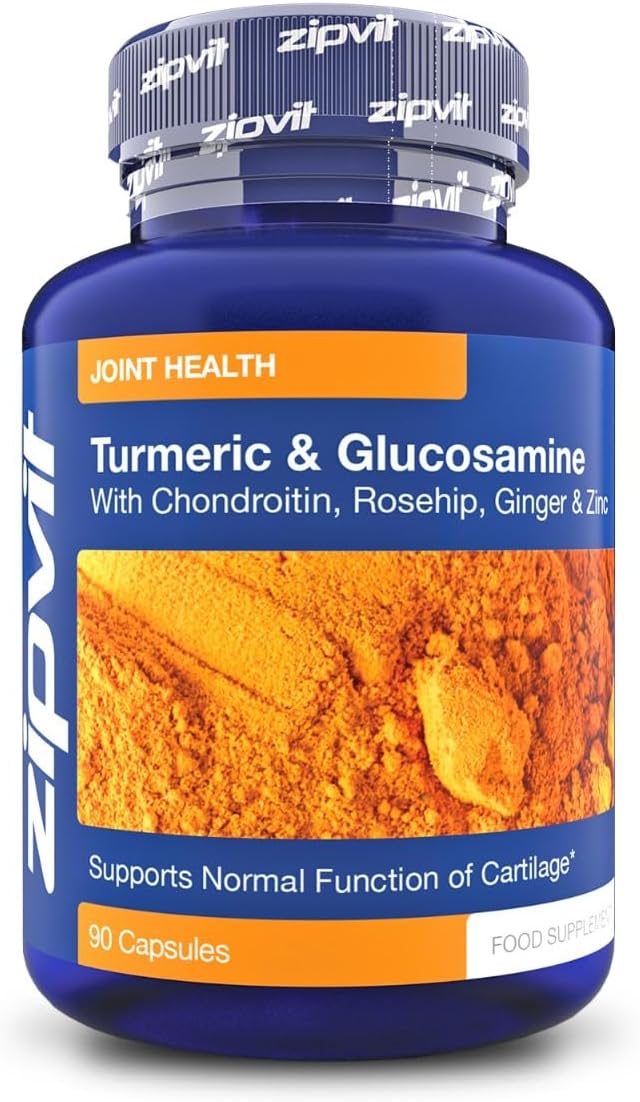
Turmeric Curcumin Plus Glucosamine and Chondroitin Complex with Added Vitamin C, Rosehip, Ginger and Zinc - 90 Capsules. Maintains Normal Joint Cartilage. UK Supplier
FREE Shipping
Turmeric Curcumin Plus Glucosamine and Chondroitin Complex with Added Vitamin C, Rosehip, Ginger and Zinc - 90 Capsules. Maintains Normal Joint Cartilage. UK Supplier
- Brand: Unbranded

Description
It has a strong anti-inflammatory effect (the strongest of all herbs, in my opinion). It’s more potent even than: Most studies have shown that both glucosamine and chondroitin are safe to use for most people and no serious side effects have been reported. Only mild side effects like stomach upset, nausea, and headache have been observed ( 13, 17). While regularly consuming turmeric in foods is fine, you should be careful when consuming it as a supplement, since it likely has a higher concentration of curcumin. Turmeric spices contain around 3% curcumin while supplements may contain up to 95% curcumin. This may leave you wondering whether you should take glucosamine and chondroitin or if you’re better off without them.
Pizzorono JE, et al., eds. Glucosamine. In: Textbook of Natural Medicine. 5th ed. Elsevier, 2021. https://www.clinicalkey.com. Accessed Oct. 24, 2020. Instead, look for a joint support formula that supplies glucosamine and turmeric at the following dosages: Giving curcumin with piperine enhances the absorption of curcumin which may have safety implications. Fortunately, glucosamine (and other key joint support ingredients that we’ll cover below) don’t negatively interact with turmeric.Hui AY et al. A Systems Biology Approach to Synovial Joint Lubrication in Health, Injury, and Disease. Wiley Interdiscip Rev Sys Biol Med. 2012 Jan-Feb; 4(1): 15-37. These mixed recommendations may partially stem from the fact that the manufacturer and type of the supplements can result in different study results. For example, pharmaceutical-grade varieties appear more effective compared with over-the-counter options ( 4, 5). Summary Typically derived from shellfish, glucosamine supplements are often taken to combat collagen deterioration and protect synovial fluid, the lubricant that keeps joints moving smoothly and comfortably. Not all glucosamine is sourced from shellfish, as demonstrated by Performance Lab® Flex’s corn-sourced glucosamine. It’s not as concentrated as the supplements. So most of the times – the final effect isn’t amazing. In the same study, 1250 mg/day of glucosamine hydrochloride, 1,200 mg/day of chondroitin sulfate, 100 mg/day of diacerein, 300 mg/day of avocado-soybean unsaponifiable (ASU), and a placebo didn’t change NSAID use ( 8).
Though more direct and specific in its bioactivities, compared to turmeric’s multiple health benefits, glucosamine comes with a number of joint-related benefits, including: Chondrocyte Support Uribarri J et al. Advanced Glycation End Products in Foods and a Practical Guide to Their Reduction in the Diet. J Am Diet Assoc. 2010 Jun; 110(6): 911-16. Osteoarthritis. Oral use of glucosamine sulfate might provide some pain relief for people with osteoarthritis of the knee. Some research shows that it may also help slow knee joint degeneration associated with osteoarthritis. More studies are needed to determine the benefits of glucosamine sulfate supplements for osteoarthritis of the hip, spine or hand. The short answer is yes you can take turmeric and glucosamine together. In fact, taking turmeric and glucosamine at the same time is optimal for promoting joint health and flexibility. No interactions were found between Glucosamine & Chondroitin with MSM and turmeric. Because glucosamine products might be derived from the shells of shellfish, there is concern that the supplement could cause an allergic reaction in people with shellfish allergies.
If you’re interested in trying glucosamine and chondroitin, speak with a healthcare professional first to determine whether it’s right for you. Turmeric is one of the most used spices in Asian cuisine. This yellow spice has been hailed for its healing properties for centuries. A turmeric latte is touted for its myriad health benefits. Turmeric contains several anti-inflammatory compounds collectively called curcuminoids.
In this case, it was possible that an ingredient in the supplement other than turmeric caused the effect. Blood Pitting oedema and itching are uncommon with turmeric, but have been reported in people who took turmeric orally. But I know the capsule is meant to protect the powder inside, so I don’t recommend you to take it off.
Free radicals (oxidative stress), the reactive chemical species associated with cellular damage, play a significant role in the pathogenesis of inflammatory joint issues—not to mention in other unwelcome consequences of stress and aging. Involved in the immune response, COX-2 is upregulated in inflamed joint tissues, where the enzyme’s proinflammatory effects may detrimentally impact joint health, whereas MMP weakens connective tissues by degrading extracellular matrix proteins. Another 2015 study also found that combined glucosamine and chondroitin supplements were comparably effective as celecoxib ( 16).
By eliminating the effect of advanced glycation end-products, turmeric’s curcumin offers significant protective advantages for joint connective tissues, as well as for the cardiometabolic system and brain health. Is It Safe to Take Glucosamine and Turmeric Together? When taken in combination with these drugs, turmeric increases the body’s production of stomach acid. This may cause nausea, bloating and stomach pain, and damage to the esophagus. Though the two can be taken separately, glucosamine and chondroitin are commonly taken as a single supplement. This combination has been more extensively studied.Hadjigogos K. The role of free radicals in the pathogenesis of rheumatoid arthritis. Panminerva Med. 2003 Mar; 45(1): 7-13. However, keep in mind that glucosamine is commonly derived from chitin — a compound found in shellfish. Therefore, those with a shellfish allergy should read the label carefully and opt for varieties made from cows or pigs ( 17).
- Fruugo ID: 258392218-563234582
- EAN: 764486781913
-
Sold by: Fruugo
